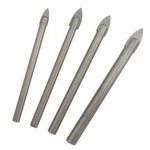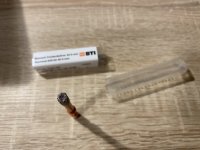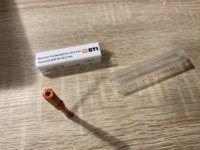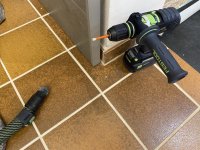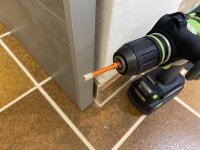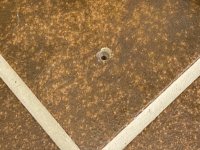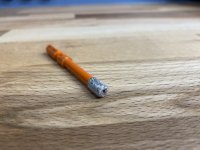six-point socket II
Member
- Joined
- Jun 26, 2016
- Messages
- 2,232
I need to drill in tile/ceramics on a project that is close to being finished. Not the typical "single accessory add on" that requires two holes, but round about 30 holes in total. 6 & 8 mm.
The couple of holes I needed to drill into tile/ceramics in the past were drilled using the Festool CE Stone drill bits (or Bosch multi construction drill bits) and under extensive (water) cooling. That works generally, but it is not exactly the fastest nor most convenient solution.
I was chatting with one of my suppliers the other day, because I'm generally interested in Eibenstock's battery powered diamond wet cutting drill. ->https://www.eibenstock.com/en/produ...-wet-core-drilling/diamond-wet-drill-end-40-a
In my opinion its an interesting machine powered by Metabo CAS batteries & there are adapters available directly from the manufacturer so you can use existing (angle grinder) drill bits with M14 thread, for example.
The supplier then recommended also looking into dry cutting with Paraffin/wax core cooled diamond dry cutting drill bits which are available with 1/4" hex shaft for drill/driver use and M14 thread for angle grinder use.
I did my research, and now I would like to hear "the good, the bad, the ugly" from real world experience.
The idea of dry cutting with a self cooling drill bit and using regular dust extraction is very intriguing to me, actually more than a new machine, even if water cooled, right now.
The main difference seems speed. The water-cooled Eibenstock linked above will drill with 8000 RPM (no load), if I use the self cooling dry cutters I'm limited to 1500 RPM and depending on manufacturer/supplier to different cooling off times/ use cases. I have not found reliable information on the M14 thread bits, if they require an angle grinder with speed control. Because if they don't, they will go far beyond 1500 RPM.
Looking deeper into that, there are suggestions of drilling not more than 30 seconds at a time with those self cooling dry cutters, others simply say not recommended for serial drilling.
To me that is a big difference. The first suggestion is pretty clear, the latter, well - I would think that - drilling two or three holes into the tile/ceramics with the self cooling drill bits, then switching to regular drill bits to finish said holes, fixing the accessories, then going for the next holes with the self cooling bits, (...) - is not exactly exzessive/ or "serial drilling".
But judging by ratings/ user reviews I've read, a fair amount of people have ruined these self cooling diamond dry cutting drill bits and were not too fond of them.
The price for a set of the self cooling drill bits (6 - 14mm) is about half of the price I was quoted for the water cooled battery powered drill. If I only buy the 6 and 8mm sizes I currently need, it's significantly cheaper - however only if I get more than the 30 holes out of them and can occasionally use them in the future. If I go with the water cooled batter powered machine, that is rated for core drilling up to 40mm, I have significantly more options considering future projects.
Has anyone used these Paraffin/wax core cooled diamond dry cutting drill bits and wants to share about the use and experience with them?
Thank you!
Kind regards,
Oliver
The couple of holes I needed to drill into tile/ceramics in the past were drilled using the Festool CE Stone drill bits (or Bosch multi construction drill bits) and under extensive (water) cooling. That works generally, but it is not exactly the fastest nor most convenient solution.
I was chatting with one of my suppliers the other day, because I'm generally interested in Eibenstock's battery powered diamond wet cutting drill. ->https://www.eibenstock.com/en/produ...-wet-core-drilling/diamond-wet-drill-end-40-a
In my opinion its an interesting machine powered by Metabo CAS batteries & there are adapters available directly from the manufacturer so you can use existing (angle grinder) drill bits with M14 thread, for example.
The supplier then recommended also looking into dry cutting with Paraffin/wax core cooled diamond dry cutting drill bits which are available with 1/4" hex shaft for drill/driver use and M14 thread for angle grinder use.
I did my research, and now I would like to hear "the good, the bad, the ugly" from real world experience.
The idea of dry cutting with a self cooling drill bit and using regular dust extraction is very intriguing to me, actually more than a new machine, even if water cooled, right now.
The main difference seems speed. The water-cooled Eibenstock linked above will drill with 8000 RPM (no load), if I use the self cooling dry cutters I'm limited to 1500 RPM and depending on manufacturer/supplier to different cooling off times/ use cases. I have not found reliable information on the M14 thread bits, if they require an angle grinder with speed control. Because if they don't, they will go far beyond 1500 RPM.
Looking deeper into that, there are suggestions of drilling not more than 30 seconds at a time with those self cooling dry cutters, others simply say not recommended for serial drilling.
To me that is a big difference. The first suggestion is pretty clear, the latter, well - I would think that - drilling two or three holes into the tile/ceramics with the self cooling drill bits, then switching to regular drill bits to finish said holes, fixing the accessories, then going for the next holes with the self cooling bits, (...) - is not exactly exzessive/ or "serial drilling".
But judging by ratings/ user reviews I've read, a fair amount of people have ruined these self cooling diamond dry cutting drill bits and were not too fond of them.
The price for a set of the self cooling drill bits (6 - 14mm) is about half of the price I was quoted for the water cooled battery powered drill. If I only buy the 6 and 8mm sizes I currently need, it's significantly cheaper - however only if I get more than the 30 holes out of them and can occasionally use them in the future. If I go with the water cooled batter powered machine, that is rated for core drilling up to 40mm, I have significantly more options considering future projects.
Has anyone used these Paraffin/wax core cooled diamond dry cutting drill bits and wants to share about the use and experience with them?
Thank you!
Kind regards,
Oliver

